Ahmedabad ranks among one of the largest cities in the westernmost state of Gujarat. The entire city is located on the shores of the holy Sabarmati River with a population of 5.2 million. Ahmedabad is spread in an area of 205 km². Ahmedabad was the capital of the state of Gujarat from 1960 to 1970; Ahmedabad is known for its booming textile industry, and has earned recognition as “the Manchester of the East.” During India’s Freedom Struggle, Ahmedabad became the centre stage of many freedom movements such civil disobedience movement.
Sultan Ahmed Shah had laid foundation of Ahmedabad in 1411 A.D. and the city was named after him. Under the British rule, Ahmedabad got its military cantonment and the city was expanded and modernized.
In 1960, when the state of Gujarat was created, Ahmedabad established itself as the commercial capital of the state. In recent years, the city has been witnessing a tremendous construction boom and rise in population. The city is fast gaining prominence as an upcoming centre of education, information technology and science-based industries. At the same time, Ahmedabad enjoys its distinction as the cultural hub of the entire western India.
River Sabarmati divides Ahmedabad into two distinct parts eastern and western regions. The old city of Ahmedabad is located in the eastern bank of the river. This part of the city is relatively congested with clustered buildings, busy streets, jam-packed bazaars and many religious complexes are dotted all over the state. The Ahmedabad Main Railway Station is in this part of the city. During the British Rule, the city along the Western Coast of Sabarmati witnessed its expansion as well as development. Modern buildings, educational institutions, well-planned urban settlements, shopping complexes all are found in this part of the city.
Climate
Ahmedabad has a tropical Savanna climate with three main seasons – summer, monsoon and winter. The summer season lasts here from March to June with the average maximum temperature of 45°C, and the average minimum temperature of 23°C. From the months of November to February, it’s winter season here with the average maximum temperature of 30°C and the average minimum temperature of 15°C. The average downpour in the city is 93.2 cm and irregular heavy torrential rain causes the river to flood. In recent times, the city has witnessed substantial increase in air, water and soil pollution due to the industrial units and textile mills thriving in the neighborhood.
Civic Administration
Ahmedabad Municipal Corporation (AMC), is the administrative authority of the Ahmedabad city. The city is further divided into 43 wards and corporators are elected from each of the wards. There are 129 elected corporators from 43 wards. The Gujarat High Court is also located at Ahmedabad.
Economy
In 1861 A.D., the first Indian textile mill named the Ahmedabad Spinning and Weaving Company Limited was founded at Ahmedabad. Thereafter a series of textile mills were established in Ahmedabad. After textiles, chemicals and pharmaceuticals industry is also very prosperous in Ahmedabad. Zydus Cadila and Torrent Pharmaceuticals are the pharmaceutical giants of India based in the city. Ahmedabad is the corporate headquarters of the Adani Group, is a top notch multinational Trading and Infrastructure Development Company. The leading detergent and chemical manufacturer Nirma group of industries has also its corporate headquarters in Ahmedabad. In recent years, many MNCs have set up their base in the city.
Ahmedabad has significant representation in the information technology sector as well. According to a NASSCOM survey, Ahmedabad stands in the fifth place among the top nine most competitive cities in the country. Ahmedabad is ranked among one of the largest suppliers of denim along with being one of the biggest exporters of gems and jewelry in the country.
The majority of the citizens of Ahmedabad are into trading and business. This fact is instrumental in driving the economy of the city to the top most strata in the country. The educational and industrial organizations of the city have attracted students and skilled workers from all parts of India.
Culture
Ahmedabad is the centre of all the cultural activities and the land of diverse traditions of various ethnic and religious communities living in Gujarat. The popular festivals include Uttarayan which is an annual kite-flying day held on 14th January every year. Navratri is the most popular festival here and people Perform Garba on the occasion of Navratri. Other important festivals are Holi, Ganesh Puja, Eid-ul-Fitr and Christmas.
Gujarati cuisine is world famous for its wide variety of vegetarian dishes. People of Ahmedabad have rich culinary traditions. There are many restaurants in Ahmedabad that serve a wide variety of Gujarati cuisines.
Transportation
The Sardar Vallabhbhai Patel International connects Ahmedabad with cities across India and the world with both domestic and international flights taking place from here.
Ahmedabad is connected to all towns in Gujarat and all major Indian cities through railways. The MetroLink Express Gandhinagar and Ahmedabad Company Ltd is a special purpose vehicle (SPV) for the metro rail project which connects Ahmedabad with Gandhinagar. National Highway 8 that is stretched between Delhi and Mumbai which passes through Ahmedabad. NH 8 connects Ahmedabad with Gandhinagar. The National Expressway 1 which is the part of the famous Golden Quadrilateral project that connects Ahmedabad with Vadodara. For local transportation, one can rely on local bus service run by the Ahmedabad Municipal Transport Service (AMTS).
Education
Most schools in Ahmedabad are affiliated with the Gujarat Secondary and Higher Secondary Education Board besides few schools which are affiliated to the Central Board for Secondary Education. There are many colleges in the city which are mostly affiliated with Gujarat University. There are couple of deemed universities in Ahmedabad which are Nirma University of Science & Technology and Dr. Baba Saheb Ambedkar Open University. Mahatma Gandhi had instituted Gujarat Vidyapith in 1920 which became a deemed university in 1963. Other important institutions in Ahmedabad are Indian Institute of Management, the National Institute of Design, the Mudra Institute of Communications, and the Entrepreneurship Development Institute of India.
Architectural
Dada Harir Stepwell, Ahmedabad
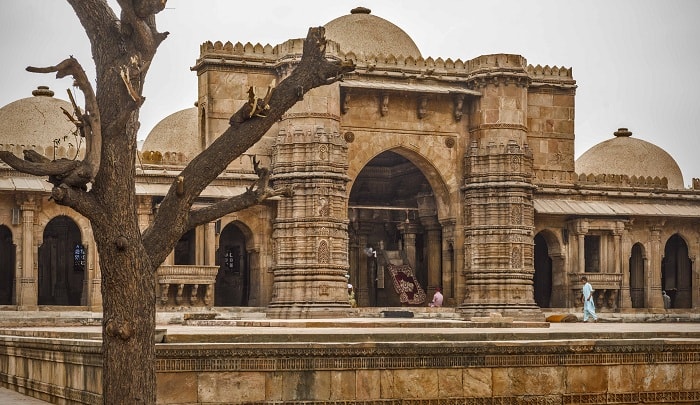
Dada Hari Vav is an ancient monument in Ahmedabad that was built in 1501 A.D. at the time of rule of Mahmud Begada. This is a step well-constructed in an octagonal shape and is one of the important tourist places in the city.
Dada Hari Vav showcases a fine blend of Muslim traditional architecture and Hindu sculpture skills. The step well contains highly festooned arches and columns beside floral sculptures and delicate carvings. Each facade of Dada Hari Vav step well is decorated amazingly.
Today, Dada Hari Vav is in its remnant conditions, but still it attracts a large crowd that gathers there to appreciate the splendor of yesteryears.
Art & Museum
Lalbhai Dalpatbhai Museum, Ahmedabad
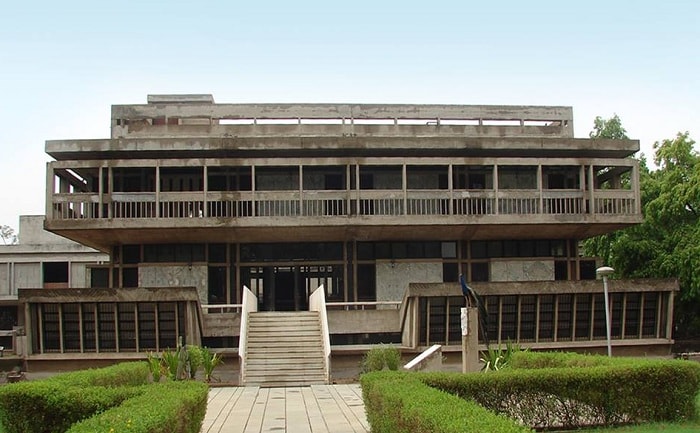
Lalbhai Dalpatbhai Museum is located close to the Gujarat University in the Navrangpura area in Ahmedabad. The museum was established in 1984 by Muni Shri Punyavijay Ji and Shri Kasturbhai Lalbhai.
Lalbhai Dalpatbhai Museum has a very good collection of Indian miniature paintings, terracotta, stone sculptures, bronzes artifacts, textiles and cloth paintings, woodworks, metal sculptures, ancient coins. It has also on display a variety of paintings of Rabindra Nath Tagore, and also arts and relics from Nepal and Tibet.
Lalbhai Dalpatbhai Museum, with about 45,000 printed books and 75,000 manuscripts, boasts of having the largest collection of books and manuscripts related to Jain literature. The museum is one of the most beautiful tourist destinations in Ahmedabad.
Calico Museum of Textiles, Ahmedabad
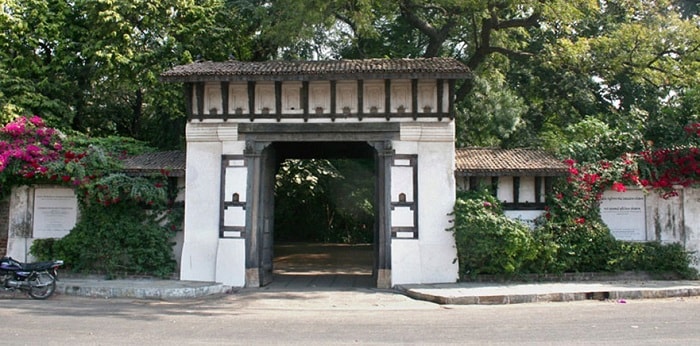
The Calico Textile Museum at Ahmedabad is an institution of its kind in the country and is one of the most accepted tourist attractions in the state of Gujarat. This is the leading textile museum that has a widespread collection of textiles and relics.
The Calico Textile Museum was founded in 1949 by the capitalist Gautam Sarabhai and today it is managed by the Sarabhai Foundation. The museum is located at the Sarabhai House in Shahibaug area of Ahmedabad city.
The items on display at this museum are well protected from dust, air pollution and other adverse climatic conditions. The maintenance of the museum and the artifacts wins the hearts of the visitors coming to this museum.
Gujarat Science City Museum, Ahmedabad
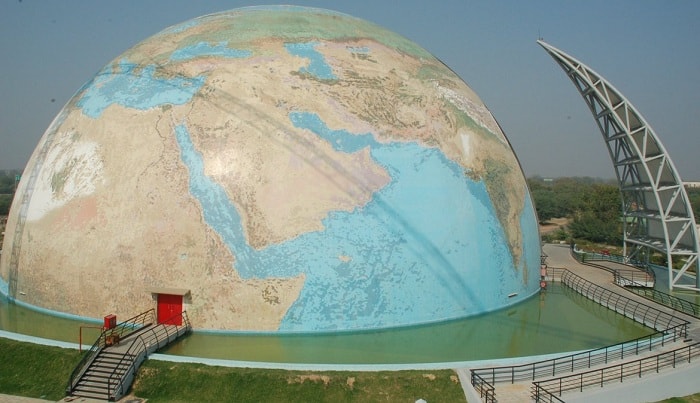
Science City is a sprawling institution situated at Ahmedabad which shows the initiatives of the Government of Gujarat to popularize science in the state. The City aims at creating a centre where science learning can be a fun-filled activity. The Science City showcases several modern and creative learning tools, mind games, virtual reality program stations, activity tools, and live demonstrations to impart knowledge on science and technology to the visitors, and specially the children.
At present, the Science City is spread in area of 107 hectares and further 300 hectares of land is to be added to expand this Science City. Visitors need to walk around this extensive complex to explore working models of modern scientific inventions.
Beaches, Lakes & Falls
Vastrapur Lake, Ahmedabad
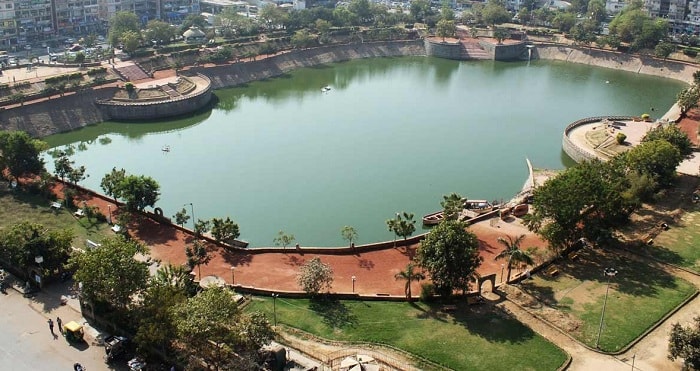
Vastrapur Lake is situated majestically in the western region of the city of Ahmedabad. Ahmedabad Municipal Corporation beautified the lake and turned it into a popular tourist spot in the city. At a distance of about 1 km from the lake, Indian Institute of Management, Ahmedabad is located. The Sarkhej-Gandhinagar highway is at about 5-10 minutes away from the lake and is easily approachable from there.
Vastrapur Lake converts itself into a picnic hotspot during each weekend. A number of people visit this lake and enjoy the serene environment of the place. The lake complex comprises of an open air theatre, and has a very good boating facility. The pathways found all around the lake can be seen occupied by many health-conscious walkers and joggers during the early morning and the evening hours.
Kankaria Lake, Ahmedabad
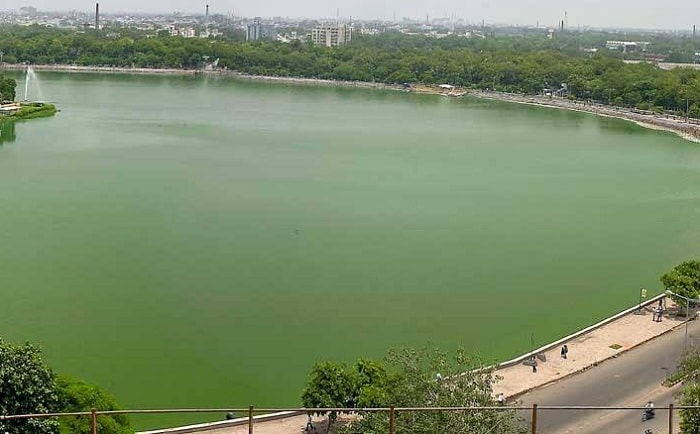
Kankaria Lake, is the biggest lake in Ahmedabad. It is located in Maninagar area which is in the southern part of the city. Sultan Qutbuddin is said to build this Kankaria Lake in 1451 A.D. and it was known by the name of Hauz-E-Qutub at that time.
Kankaria Lake used to have a water purification system which is non-existent now. This circular lake has a pathway which takes the tourists to a beautiful garden called Nagina Wadi. Nagina Wadi is located in the middle of the lake. There is a gymnasium within the vicinity of Kankaria lake campus known by the name of Ambubhai Vyayamshala.
Historical Places
Sarkhej Roza Mosque, Ahmedabad
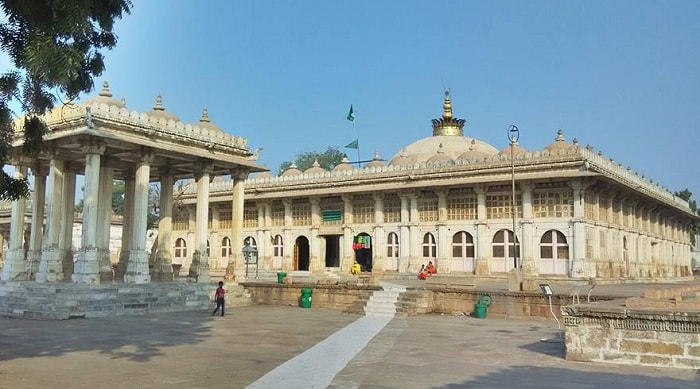
Sarkhej Roza can be characterized as one of the most stylish and distinctive architectural marvels of Ahmedabad. Sarkhej Roza showcases an example of the early Islamic architectural style that has a great influence of Persian architecture. At the same time, the indigenous Hindu and Jain architecture styles have their own significant presence in the complex. In true sense, the architectural style of the complex is a real amalgamation of Islamic, Hindu and Jain styles.
Sarkhej Roza complex is located in a village at a distance of about 10 kilometres from the Ahmedabad city. The Roza complex is one of the finest examples of campus planning, where the religious, royal and social facets of human life once co-existed without losing their identity.
Jhulta Minara Sidi Bashir Mosque, Ahmedabad
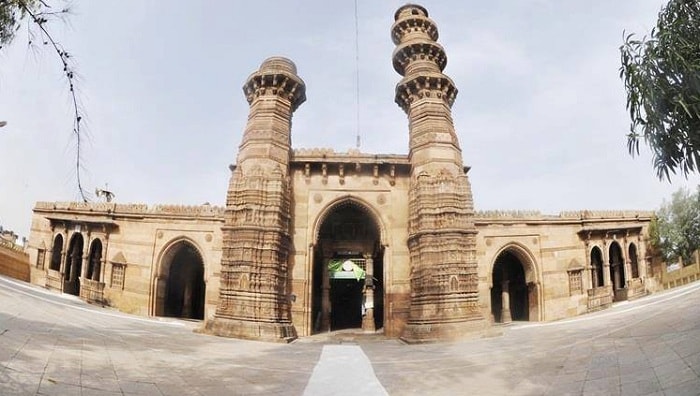
The Jhulta Minara in Ahmedabad is an example of wonderful constructions of our bygone eras. This architectural grandeur is still an object of great curiosity for the architects and designers of the present times.
The Jhulta Minara has its own specialty. When someone gives a little push on the top most arch of the Minara, it starts moving back and forth. This is the reason why it is popularly called the Jhulta Minara or the swaying towers.
The Jhulta Minara is an integral part of the Sidi Bashir Mosque. The towers are astounding example of architectural craftsmanship and even after so many years, the grandeur and elegance of the structure is still intact.
Shaking Minarets, Ahmedabad
Shaking Minarets, or also known as Jhulta Minara, is an integral part of the Sidi Bashir Mosque located in the city of Ahmedabad. The minarets or towers at this mosque have unique distinction of shaking for few seconds, once one of the minarets is pushed a little. Due to this reason, the monument is called popularly as the Shaking Minarets.
Sidi Bashir Mosque is said to be built in 1452 A.D. by Sidi Bashir, who was a slave of Sultan Ahmed Shah. The Shaking Minarets is located opposite to the Ahmedabad Railway station and is one of the most accepted tourist destinations for the tourists reaching the city of Ahmedabad.
Teen Darwaza, Ahmedabad
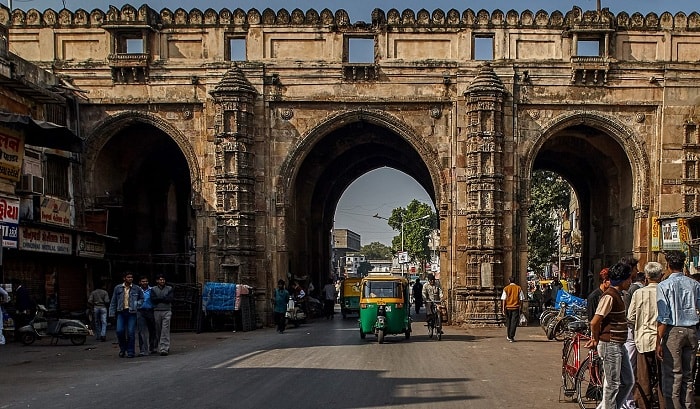
Teen Darwaza is among one of the longest along with being one of the oldest gateways in Ahmedabad. This is truly an architectural wonder consisting of stunning arched gates and was established in 141 A.D. by Sultan Ahmed Shah, who also happens to be the founder of the Ahmedabad city.
Teen Darwaza is located next to the well-known Bhadra fort, and one could also consider it as an entry point to the Royal Square at Bhadra Fort. The walls and pillars of this grand gateway are magnificently adorned and is a fine example of Islamic architecture in India.
Teen Darwaza once used to serve as a spectators ground to witness the numerous processions and other religious ceremonies that used to take place at the sprawling space in between the gate and the Bhadra Fort.
Religious
Jama Mosque, Ahmedabad
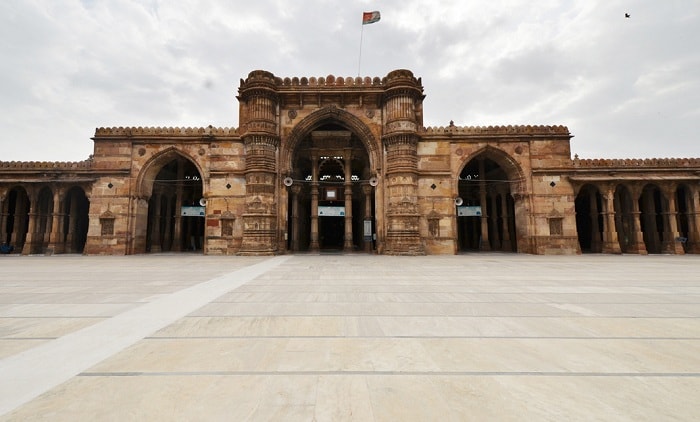
Jama Masjid is located in the heart of the old city of Ahmedabad and portrays an intelligent blend of both Hindu and Muslim architectural styles.
Jama Masjid was built in 1423 A.D. during the rule of Sultan Ahmed Shah. The mosque is constructed with yellow sandstone and attracts the attention of the art loving folks who come to see this marvelous monument.
The western chamber of the mosque contains 260 pillars with excellent carvings and perhaps is the most fascinating portion of this religious shrine. The mosque comprises of a large rectangle shaped courtyard made of white marbles, and a pool in its middle serves as a perfect retreat to the visitors.
Sidi Saiyyed Mosque, Ahmedabad
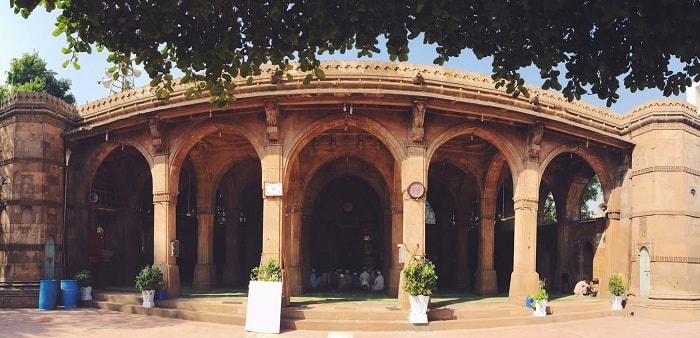
Sidi Saiyyed Mosque is one of the most famous mosques of the Ahmedabad city. The mosque was built near Lal Darwaza in 1573 A.D. by a slave of Sultan Ahmed Shah named Sidi Saiyyed.
Sidi Saiyyed Mosque has ten semi-circular windows, and gained a worldwide recognition due to the splendid mesh covering the windows, which is more popularly known as Jalior screens. The Skilfully carved Jali is truly an artist’s work and attracts attention of the visitors from across the world.
The rear wall of the mosque is filled with square stone panels which are cut in geometrical designs. This delicately carved stone window panel is popularly called as the Sidi Saiyyed Jali.
ISKCON Radha Krishna Temple, Ahmedabad
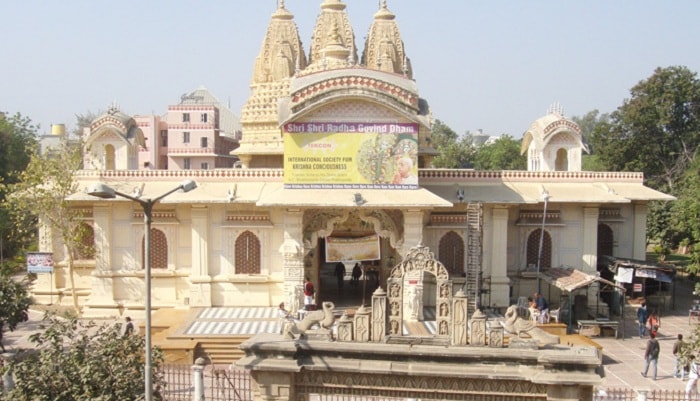
ISKCON stands for International Society for Krishna Consciousness. ISKCON Temple is dedicated to Lord Krishna and is also known as the Hare Krishna Temple. Considered as an epitome of true love, the temple offers spiritual blessings to the devotees coming to this temple in search of mental bliss.
ISKCON temple is situated in a lovely and serene environ in the Ahmedabad city with a number of majestic trees all around. The spacious halls with ornamented and beautiful chandeliers present the classy interiors of the temple. During the prayer sessions, the entire temple is brimming with the harmonic chanting of sacred hymns that have a magical soothing effect over the devotees.
Everyday scores of tourists come to this magnificent temple to offer their prayers to Lord Krishna. The festivities of Janmashtami and Nand Mahotsav witness a huge crowd of devotees in the premises of the temple.
Hutheesing Jain Temple, Ahmedabad
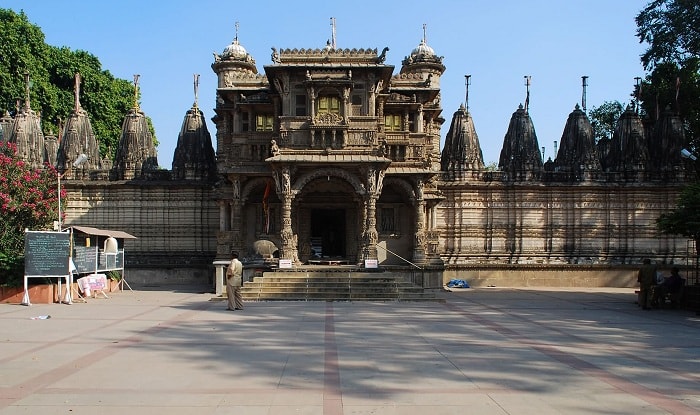
Hathee Singh Temple is situated in the Shahibaug Road in Ahmedabad. Dedicated to Dharmnath, the 15th Tirthankara of Jains, the construction of this temple is attributed to a rich Jain merchant Sri Hathee Singh and hence the name Hathee Singh Temple.
Hathee Singh Temple is a two-storey building made of white marble and its brilliant structural designs offer a delightful experience to the onlookers. The temple has intricate porches in its three sides. The front porch bears a lovely dome that gives this temple an unusual architectural appeal. The delicate carved patterns adorn the other two porches.
Tourists visiting to Ahmedabad never miss to visit Hathee Singh Temple, as the tremendous splendor and magnificence of the temple is a memorable experience for them.
Gandhi Ashram (Sabarmati Ashram), Ahmedabad
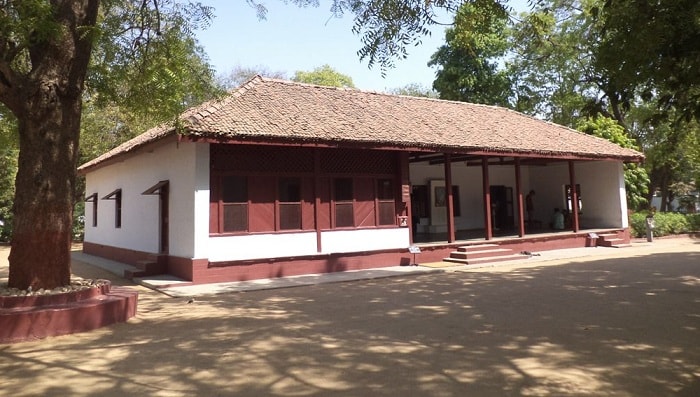
Gandhi Ashram or Sabarmati Ashram is located on the shores of the holy river of Sabarmati in Ahmedabad. Now this Ashram houses a museum called Gandhi Smarak Sangrahalaya which was erected in 1963. The museum is an institution that propagates the Gandhian value for the sustenance of mankind on this earth.
Innumerable visitors, both from India and abroad arrive at this abode of peace to get inspiration from the life of the messenger of peace, Mahatma Gandhi. Millions of tourists visit the ashram every year. Gandhi Ashram is a source of motivation for the present generation, and will serve the same purpose for the generations to come.
Amar Dham, Ahmedabad
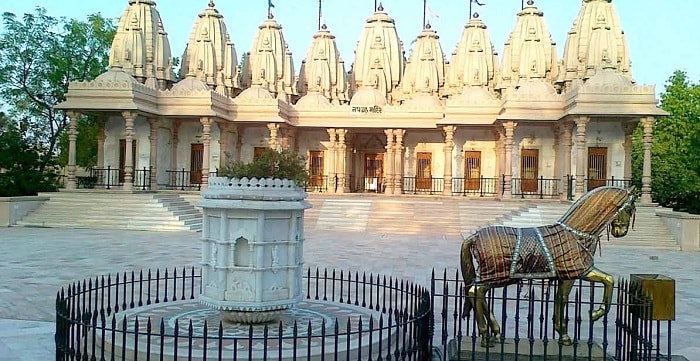
Amar Dham is one of the popular religious sites of Gujarat and located in Ahmedabad. This is a famous pilgrimage and a familiar spot for the devout people who from every part of Gujarat come here to offer their prayers to the Supreme God.
Amar Dham is also a famous destination for the art lovers due to its unique rendering of architectural design. Besides being a prominent sacred place, the place has its own architectural importance.
A serene environment coupled with religious divinity and wonderful structural patterns attracts scores of people from across the country. At Amar Dham, people can spend their valuable time in a calm environment and enjoy the divine blessings as well.
Vaishno Devi Mandir, Ahmedabad
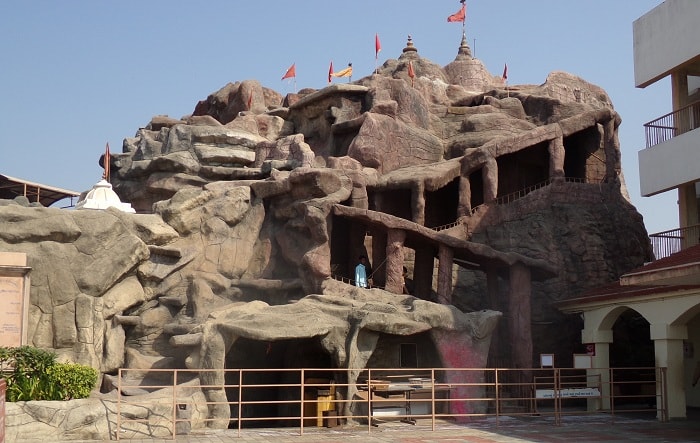
Vaishno Devi Temple is a popular religious shrine situated on Ahmedabad – Gandhinagar road and is a famous site among the devotees. This temple at Ahmedabad is a true replica of the world famous Vaishno Devi shrine located in Jammu and Kashmir.
The temple is located at an uphill spot but the ascending journey towards the temple becomes more pleasant due to existence of many small garden restaurants on the way. The visit to the temple can be enjoyed as a heart-felt outing besides enjoying divine blessings.
The temple is visited by huge crowds throughout the year. Not only religious pilgrims but also general tourists visit this temple with great reverence.
Akshardham Temple, Ahmedabad
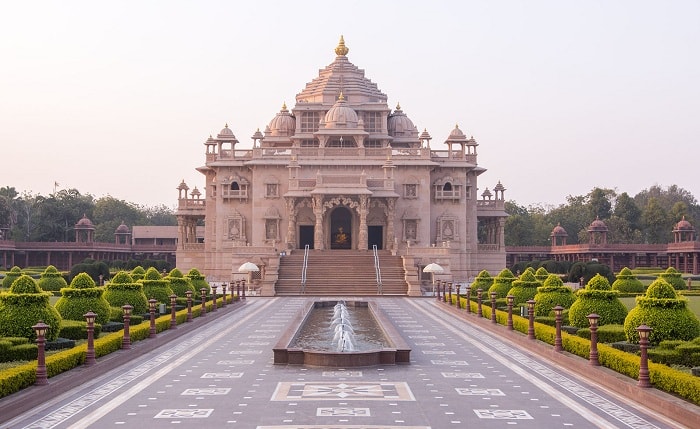
The Akshardham Temple is located amidst a spacious garden called Sahajanand Van which is 28 kilometres away from the Ahmedabad city. The temple presents a mixture of traditional magnificence and rich cultural legacy and attracts more than millions of visitors every year. The temple is a sacred place for the followers of Lord Swaminarayan and situated on the banks of Sabarmati River.
Akshardham Temple is dedicated to Lord Swaminarayan and thus also known by the name of Swaminarayan Temple. The temple houses gold or copper plated idols of Lord Swaminarayan.
The temple presents a distinctive architectural style of Gujarat. More than 6000 metric tons of attractive pink sandstone was brought from Rajasthan to build this magnificent temple.
Shopping
Law Garden, Ahmedabad
Law Garden is located at the heart of the city of Ahmedabad and is a famous hotspot for buying Gujarati handicrafts and traditional outfits which the local hawkers come to sell here. Besides, the garden offers various recreational options like folk music, theater, rides for the children. The food lovers too can taste a great variety of delicacies of Gujarat. Law Garden has something for everybody whether you are young or old.
The garden owes its name to the Law College which is situated to its close proximity. The garden is so expansive that most of the time it is found occupied with music and dance concerts. Law Garden is a must visit for the tourists coming to Ahmedabad.
Wildlife
Nal Sarovar Bird Sanctuary, Ahmedabad

Nal Sarovar is a natural lake which is situated 70 kilometres away from the city of Ahmedabad. This lake is a wonderful haven for many migratory birds, and thus is an ideal retreat to people who want to enjoy the absolute serenity of nature.
Nal Sarovar Bird Sanctuary is spread over an area of 116 sq km and is a natural habitat of rare and exotic birds. More than 250 species of exotic birds can be seen here besides the migratory birds coming from Siberia and other cold regions. At the dawn when sun rises, the sky over the lake can be seen full of majestic avian flocks.
Kamla Nehru Zoological Garden Kankaria, Ahmedabad
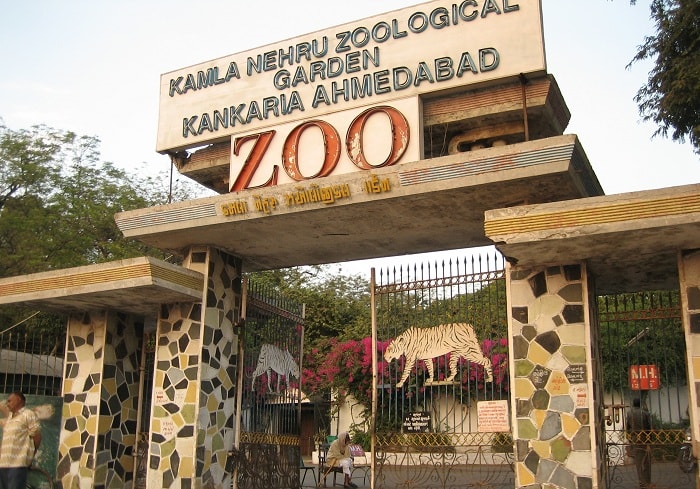
Kamla Nehru Zoo is located at the splendid banks of the placid Kankaria Lake in Ahmedabad. Kamla Nehru Zoological garden serves as a natural habitat for large number of the albino animals, feathering folk, reptiles and other mammals.
The zoo was established in 1951 and is spread over an area of 31 acres. Many endangered species like flamingos, Indian Wild Ass, Mouse Deer, Asiatic Lion and Chinkara have found their peaceful home in this zoo. The zoo also houses a museum that has scores of wildlife pictures and inflated birds.
Kamla Nehru Zoo is an ideal place for the children where they learn about various aspects of wildlife and the creatures.
Suggested Tour:
